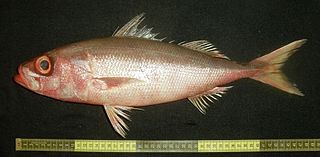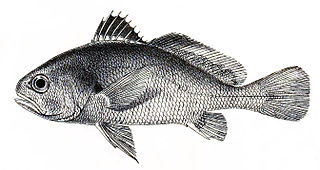
Zebrasoma is a genus of marine ray-finned fishes belonging to the family Acanthuridae which includes the surgeonfishes, unicornfishes and tangs. These fishes are found in the Indo-Pacific region.

Emmelichthyidae is a small family of small to medium-sized marine ray-finned fishes known commonly as rovers, bonnetmouths or rubyfishes.

Emmelichthys nitidus, the Cape bonnetmouth, bonnetmouth, redbait, pearl fish, picarel, red baitfish, red herring or Southern rover, is a species of marine ray-finned fish belonging to the family Emmelichthyidae, the rovers and bonnetmouths. This species is found in the Indian and Pacific oceans. This species is of minor importance to commercial fisheries.

The rubyfish, also known as the cosmopolitan rubyfish, red ruby or ruby rover, is a species of marine ray-finned fish, belonging to the family Emmelichthyidae, the rovers, bonnetmouths and rubyfishes. This species is found from the southeastern Atlantic Ocean off South Africa through the Indian Ocean to the southwestern Pacific Ocean around Australia and New Zealand. This species is commercially important.

Argyrosomus is a genus of marine ray-finned fishes belonging to the family Sciaenidae, the drums. The fish in this genus are large and are commonly targeted as game fish.
Phenacoscorpius, the no-lined scorpionfishes, is a genus of marine ray-finned fish belonging to the family Scorpaenidae, the scorpionfishes. They are native to the western Atlantic, Pacific and Indian oceans.

Micropogonias is a genus of marine ray-finned fishes belonging to the family Sciaenidae, the drums and croakers. These fishes are found in the eastern Pacific and western Atlantic Oceans.

Harpagifer, the spiny plunderfishes is a genus of marine ray-finned fishes, belonging to the family Harpagiferidae, it is the only genus in this monotypic family. They are found in the Southern Ocean.

Emmelichthys is a genus of marine ray-finned fishes belonging to the family Emmelichthyidae, the rovers and bonnetmouths. The species in this genus are found in the Atlantic, Indian and Pacific Oceans.

Erythrocles is a genus of marine ray-finned fishes belonging to the family Emmelichthyidae, the rovers, bonnetmouths or rubyfishes. The fishes in this genus are found in the western Atlantic, Pacific and Indian Oceans.
Nototheniops is a genus of marine ray-finned fishes belonging to the family Nototheniidae, the notothens or cod icefishes. The species in this genus are native to the Southern Ocean.

Otolithes ruber, commonly known as the tigertooth croaker, silver teraglin, wiretooth, snapper kob, snapper salmon, Yankee whiting or Yankee salmon is a species of marine ray-finned fish belonging to the family Sciaenidae, the drums and croakers. This species is found in the Indo-Pacific region.

Atractoscion is a genus of marine ray-finned fished belonging to the family Sciaenidae, the drums and croakers. The fishes in this genus are found in the Atlantic, Indian and Pacific Oceans.
The Atlantic rubyfish, also known as the crimson rover, is a species of marine ray-finned fish belonging to the family Emmelichthyidae, the rovers, bonnetmouths and rubyfishes. This fish is found in the eastern and western central Atlantic Ocean.

The Japanese rubyfish also known as the Pacific rover or dusky rover, is a species of marine ray-finned fish belonging to the family Emmelichthyidae, the rovers, bonnetmouths and rubyfishes. This fish is found in the Indian and western Pacific Oceans.

Johnius dussumieri, the sin croaker, Dussumier's croaker, Dussumier's silver jewfish, sharptooth hammer croaker or whiskered croaker, is a marine ray-finned fish belonging to the family Sciaenidae, the drums and croakers. This fish is found in the Indian Ocean.

Johnius carutta, the karut croaker or purple jewfish, is a species of marine ray-finned fish belonging to the family Sciaenidae, the drums and croakers. This species is found in the western Indian Ocean.

The kathala croaker is a species of marine ray-finned fish belonging to the family Sciaenidae, the drums and croakers. This species is found in the Indian Ocean off South Asia. It is the only species in the monospecific genus Kathala.

The cuja bola is a species of marine ray-finned fish belonging to the family Sciaenidae, the drums and croakers. This fish is found in the northern Indian Ocean in India, Bangladesh, Myanmar and Thailand. It is the only species in the monospecific genus Macrospinosa.

The half-mourning croaker is a species of marine ray-finned fish belonging to the family Sciaenidae, the drums and croakers. It is the only species in the monospecific genus Paranibea. This fish is found in the Indo-Pacific region.
















